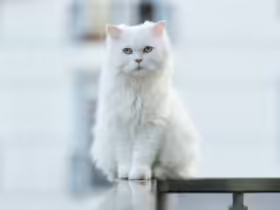Contents
Cats are curious creatures and often explore their environment by nibbling on plants. Unfortunately, many popular houseplants can be toxic to felines. To keep your cats safe, it’s important to know which plants to avoid. Here are 16 houseplants that are harmful to cats and should be kept out of reach.
1. Lily (Lilium spp.)
Toxic Components
- All parts: Contains compounds that can cause severe kidney damage.
Symptoms
- Kidney failure: Vomiting, diarrhea, lethargy, and loss of appetite.
2. Pothos (Epipremnum aureum)
Toxic Components
- Leaves and stems: Contains calcium oxalate crystals.
Symptoms
- Oral irritation: Causes burning sensations in the mouth, excessive drooling, and vomiting.
3. Philodendron (Philodendron spp.)
Toxic Components
- Leaves and stems: Contains calcium oxalate crystals.
Symptoms
- Oral discomfort: Causes mouth irritation, difficulty swallowing, and gastrointestinal upset.
4. Dieffenbachia (Dieffenbachia spp.)
Toxic Components
- Leaves and stems: Contains calcium oxalate crystals.
Symptoms
- Burning and swelling: Causes oral irritation, excessive drooling, and difficulty swallowing.
5. Peace Lily (Spathiphyllum spp.)
Toxic Components
- All parts: Contains calcium oxalate crystals.
Symptoms
- Mouth irritation: Causes burning sensations, vomiting, and difficulty swallowing.
6. Caladium (Caladium spp.)
Toxic Components
- All parts: Contains calcium oxalate crystals.
Symptoms
- Gastrointestinal distress: Causes oral irritation, vomiting, and diarrhea.
7. Aloe Vera (Aloe barbadensis)
Toxic Components
- Leaves: Contains saponins and anthraquinones.
Symptoms
- Gastrointestinal upset: Causes vomiting, diarrhea, and tremors.
8. English Ivy (Hedera helix)
Toxic Components
- Leaves and berries: Contains saponins and polyacetylene compounds.
Symptoms
- Gastrointestinal issues: Causes vomiting, abdominal pain, and diarrhea.
9. Yucca (Yucca spp.)
Toxic Components
- All parts: Contains saponins.
Symptoms
- Gastrointestinal distress: Causes vomiting, diarrhea, and abdominal pain.
10. ZZ Plant (Zamioculcas zamiifolia)
Toxic Components
- All parts: Contains calcium oxalate crystals.
Symptoms
- Oral irritation: Causes burning sensations in the mouth, difficulty swallowing, and gastrointestinal upset.
11. Sago Palm (Cycas revoluta)
Toxic Components
- All parts: Contains cycasin.
Symptoms
- Liver failure: Causes severe vomiting, diarrhea, liver failure, and potentially death.
12. Oleander (Nerium oleander)
Toxic Components
- All parts: Contains cardiac glycosides.
Symptoms
- Heart issues: Causes heart arrhythmias, vomiting, and potentially death.
13. Kalanchoe (Kalanchoe spp.)
Toxic Components
- All parts: Contains bufadienolides.
Symptoms
- Cardiac issues: Causes vomiting, diarrhea, and cardiac arrhythmias.
14. Asparagus Fern (Asparagus densiflorus)
Toxic Components
- Berries and foliage: Contains saponins.
Symptoms
- Gastrointestinal issues: Causes vomiting and diarrhea.
15. String of Pearls (Senecio rowleyanus)
Toxic Components
- All parts: Contains toxic alkaloids.
Symptoms
- Gastrointestinal upset: Causes vomiting and diarrhea.
16. Mother-in-Law’s Tongue (Sansevieria trifasciata)
Toxic Components
- All parts: Contains saponins.
Symptoms
- Gastrointestinal issues: Causes nausea, vomiting, and diarrhea.
Tips for Keeping Your Cat Safe
- Select Pet-Friendly Plants: Choose plants known to be non-toxic to cats.
- Monitor Plant Interaction: Keep an eye on your cat’s behavior around plants.
- Use Barriers: Place harmful plants in areas that are out of reach or use barriers to keep cats away.
Conclusion
Keeping toxic plants away from your cats is essential for their health and safety. By avoiding these 16 harmful houseplants and choosing safe alternatives, you can create a beautiful environment while protecting your feline friends. If you suspect your cat has ingested a toxic plant, seek veterinary care immediately to ensure their well-being.











Leave a Reply